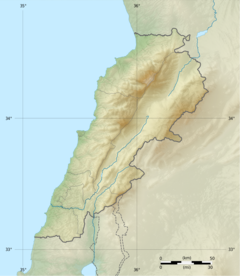Ksar Akil
| Alternate name | Ksar 'Aqil |
|---|---|
| Location | 10 km (6.2 mi) northeast of Beirut |
| Coordinates | 33°55′00″N 35°36′00″E / 33.916667°N 35.6°E |
| Type | Rock Shelter |
| History | |
| Periods | Middle Palaeolithic, Upper Palaeolithic, Epipalaeolithic |
| Cultures | Transitional/Initial Upper Palaeolithic, Ahmarian Northern Facies, Levantine Aurignacian, Antelian |
| Site notes | |
| Excavation dates | 1937-1938, 1947-1948, 1969-1975 |
| Archaeologists | J.G. Doherty: Boston College, J.F. Ewing: Fordham University, Jacques Tixier: CNRS |
| Public access | Yes |
Ksar Akil is an archeological site 10 km (6.2 mi) northeast of Beirut in Lebanon. It is located about 800 m (2,600 ft) west of Antelias spring on the north bank of the northern tributary of the Wadi Antelias. It is a large rock shelter below a steep limestone cliff.
It was first noticed by Godefroy Zumoffen in 1900 and first studied by A. E. Day in 1926 then first systematically excavated by J.G. Doherty, S.J., and J.F. Ewing, S.J., in 1937-1938 and again in 1947-1948, then later by Jacques Tixier in 1969-1975 before research was interrupted by the Lebanese Civil War.
Excavations showed occupational deposits reaching down to a depth of 23.6 m (77 ft) with one of the longest sequences of Paleolithic flint industries ever found in the Middle East. The first level of 8 m (26 ft) contained Upper Levalloiso-Mousterian remains with long and triangular Lithic flakes. The level above this showed industries accounting for all six stages of the Upper Paleolithic. An Emireh point was found at the first stage of this level (XXIV), at around 15.2 m (50 ft) below datum with a complete skeleton of an eight-year-old Homo sapiens (called , now in the National Museum of Beirut after being studied in America) was discovered at 11.6 m (38 ft), cemented into breccia. A fragment of a Neanderthal maxilla was also discovered in material from level XXVI or XXV, at around 15 m (49 ft). Studies by Hooijer showed Capra and Dama were dominant in the fauna along with Stephanorhinus in later Levalloiso-Mousterian levels.
...
Wikipedia

